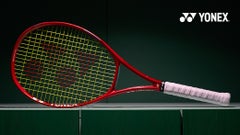Guide to Tennis String Stiffness
Soft, stiff, control, power ...
These are all common words to describe how strings feel and what they provide. We explain the role stringbed stiffness plays in performance.
According to our Tennis Warehouse University article, a tennis string's stiffness is a measurement of how much it stretches during a fast impact, like a tennis hit. The more it bends, the lower the stiffness.
High Stiffness |
Lower Stiffness |
| More Control | Less Control |
| Less Power | More Power |
| Less Comfort | More Comfort |
Strings will similar stiffness numbers will generally play similarly with regards to their power, control and comfort.
See the Tennis Warehouse University String Stiffness Database to see how all tennis strings match up!
String types
Polyester strings tend to be the stiffest and lowest-powered type of string, but they do offer the most control, spin and durability. This is why they are ideal for players with longer, faster strokes who can generate much of their own power. Players with slower strokes or looking for more power may find "polys" too stiff and uncomfortable.
Natural gut strings are generally the softest available, making them the most powerful and comfortable option. However, what makes natural gut unique is the softness that it exhibits at very high tensions. If you are looking for more control out of your natural gut, you can string it at a very high tension (60+ lbs) and it still retains its comfort, playability and feel.
Multifilament strings tend to be quite soft as well since they are designed to replicate the feel and performance of natural gut. However, they don't have the same level of playability at higher tensions like natural gut does. However, they are still a great option for players looking for power, comfort and feel at a lower price than natural gut.
Synthetic gut strings are usually right in the middle of the road when it comes to stiffness, which is why they usually are good choice for affordable all-around performance.








